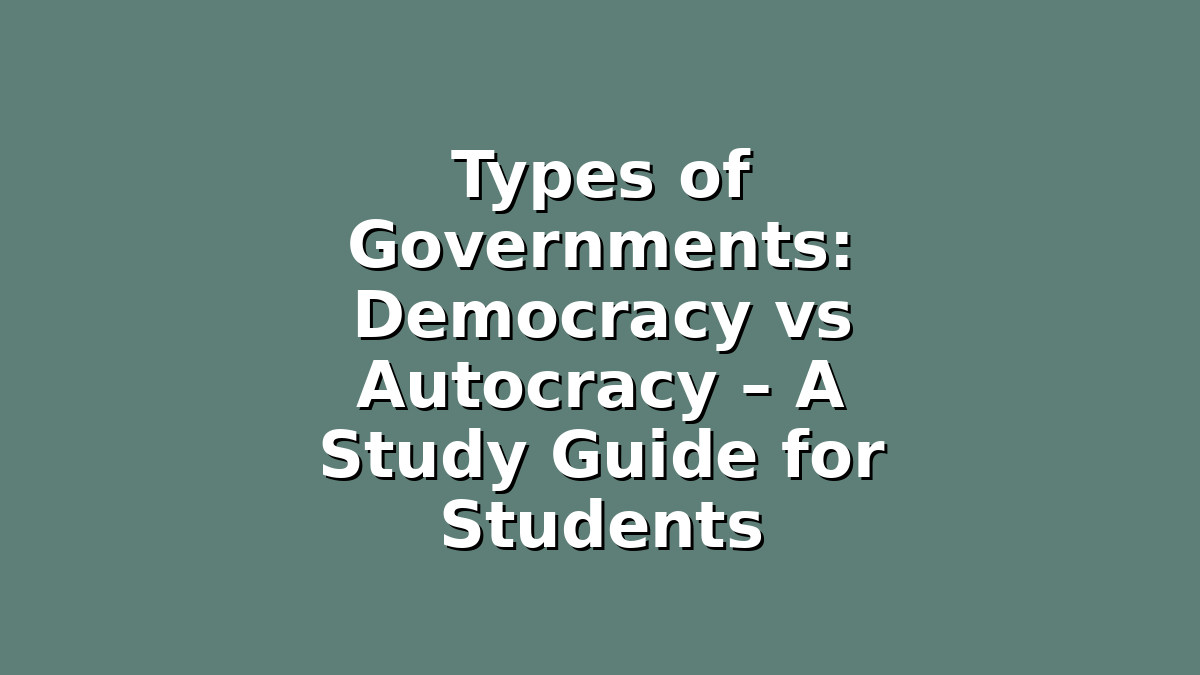When preparing for exams, understanding different types of governments is essential, especially the concepts of democracy and autocracy. These two contrasting forms of governance often appear in social studies, history, and political science exams. Knowing their features, differences, and real-world examples can help you excel in your tests. This article breaks down these government types, provides study tips, and encourages effective learning strategies to help you master this topic with confidence.
Introduction: Why Understanding Government Types Matters
Governments shape the way countries operate, influence citizens’ lives, and determine how decisions are made. For students, grasping the differences between democracy and autocracy is more than just memorizing definitions — it’s about understanding the impact these systems have on societies. Whether you’re writing essays, answering multiple-choice questions, or participating in class discussions, a clear picture of these government types will boost your overall comprehension and exam performance.
This guide will explore the core characteristics of democracy and autocracy, offer advice on how to study these concepts effectively, and suggest ways to remember key differences. Let’s dive in!
—
1. Understanding Democracy: Key Features and Study Tips
What is Democracy?
Democracy is a form of government in which power rests with the people. Citizens have the right to participate in decision-making, usually through voting in elections. Democracies emphasize freedom, equality, and rule of law.
Core Characteristics:
– Popular Sovereignty: The ultimate authority belongs to the people.
– Free and Fair Elections: People elect their leaders in regular, transparent elections.
– Protection of Rights: Citizens enjoy freedoms such as speech, assembly, and religion.
– Checks and Balances: Different branches of government limit each other’s powers.
– Majority Rule with Minority Rights: While majority decisions prevail, minority groups have protections.
Study Tips for Democracy:
– Create Flashcards: Use flashcards to memorize key terms like “popular sovereignty” and “rule of law.”
– Relate to Current Events: Connect democracy concepts to recent elections or political news to make ideas more relevant.
– Use Diagrams: Visualize how democratic institutions work, such as the election process or separation of powers.
– Practice Questions: Test yourself with past exam questions on democracy to reinforce understanding.
– Group Discussions: Discuss democracy with classmates to explore different perspectives and clarify doubts.
Remember, democracy is about participation and rights. When studying, focus on examples of democratic countries like the United States, India, or Sweden. Knowing real-world instances helps anchor your knowledge.
—
2. Exploring Autocracy: Features and Effective Study Methods
What is Autocracy?
Autocracy is a government system where one person or a small group holds absolute power. Citizens have little or no role in decision-making, and political power is often maintained through force or strict control.
Core Characteristics:
– Centralized Power: One ruler or a small elite controls all government functions.
– Limited Political Freedoms: Citizens cannot participate freely in governance or express dissent.
– No Free Elections: Leaders are typically not elected through fair processes—power is often inherited or seized.
– Control Over Media and Speech: Information is tightly controlled to maintain authority.
– Use of Force: Repression and intimidation are common to prevent opposition.
Study Tips for Autocracy:
– Compare and Contrast: Create comparison charts contrasting autocracy with democracy to highlight differences.
– Use Historical Examples: Learn about autocratic leaders like Adolf Hitler, Joseph Stalin, or Kim Jong-un to understand the practical effects of autocracy.
– Summarize Key Traits: Write short paragraphs summarizing autocracy’s features in your own words.
– Mnemonic Devices: Use acronyms or rhymes to remember characteristics (e.g., “CAP” for Centralized power, Authoritarian control, Propaganda).
– Watch Documentaries or Videos: Visual media can make autocracy’s impact clearer and more memorable.
Understanding autocracy helps you appreciate why democratic freedoms matter. While it may seem a heavy topic, breaking it into smaller parts makes it easier to study.
—
3. Comparing Democracy and Autocracy: Study Strategies for Exam Success
Side-by-Side Comparison:
Making direct comparisons is one of the most effective ways to prepare for exams. Focus on differences and similarities in areas such as leadership, citizen participation, rule of law, and civil rights.
| Aspect | Democracy | Autocracy |
|——————–|———————————|————————|
| Leadership | Elected officials | Single ruler or elite |
| Power Source | People’s vote | Concentrated authority |
| Citizen Participation | High (voting, protests, debate) | Low or none |
| Political Freedoms | Protected | Restricted |
| Media | Free and independent | Controlled by state |
Study Techniques:
– Create Mind Maps: Visual mind maps linking concepts and examples can help organize information for quick recall.
– Practice Writing Essays: Try answering questions like “Compare and contrast democracy and autocracy” to improve writing skills.
– Use Past Papers: Reviewing old test papers familiarizes you with typical question formats and helps identify important points.
– Teach Others: Explaining these concepts to friends or family reinforces your understanding and boosts confidence.
– Set Timed Quizzes: Simulate exam conditions by answering questions within a time limit to improve speed and accuracy.
Remember, understanding these systems doesn’t just help you pass exams—it builds your foundation for informed citizenship and critical thinking.
—
Conclusion: Empower Your Learning on Government Types
Studying types of governments, particularly democracy and autocracy, can seem challenging but is highly rewarding. By breaking down complex ideas into manageable chunks and using active study techniques like flashcards, comparisons, and teaching others, you’ll retain information better and feel more prepared for exams.
Keep in mind that both democracy and autocracy have real-world consequences and learning about them deepens your understanding of history, politics, and society today. Stay curious, keep practicing, and don’t hesitate to reach out to teachers or classmates if you need help.
With steady effort and the right strategies, you’ll master this topic and be confident on exam day. Good luck, and happy studying!
—

Responses